So, you are just starting your garden and you are going for a 4×8 raised bed design. The raised-bed design allows you to navigate your garden easily and reach your plants without stepping on the cultivated area.
While it permits easy navigation, one thing a raised bed garden wouldn’t do is grow plants in itself. You have to do the planting yourself. Since the space in a 4 x 8 raised bed garden is limited, there are some things to consider to ensure that you maximize the space available to you.
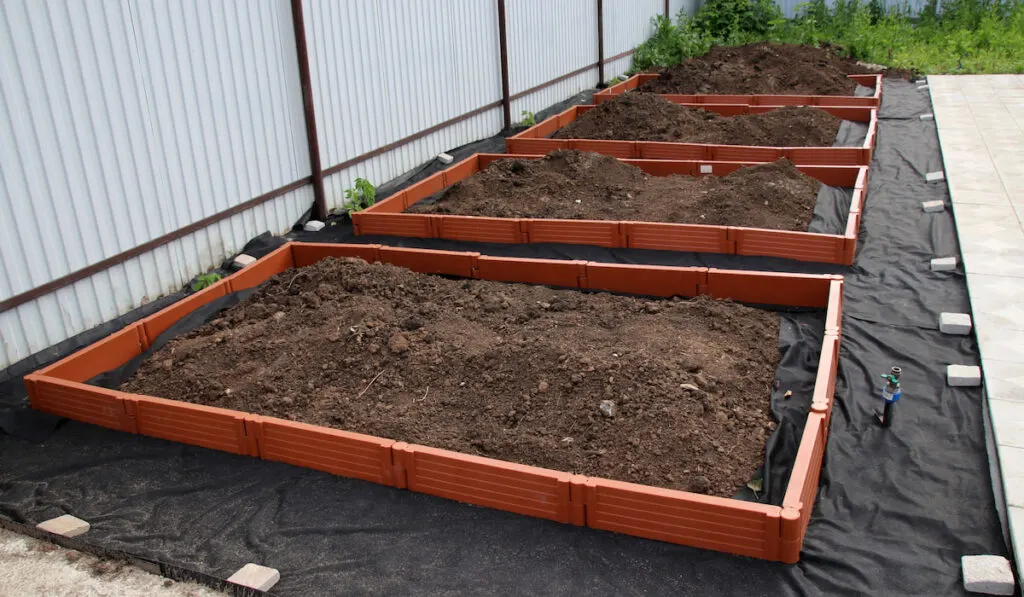
Below, we will talk about the best way to arrange and space your plants in your garden. We will also share ideas on what to plant based on some of your favorite meals.
Table of Contents
Figuring Out Garden Spacing
Apart from allowing you to easily navigate the plants, having raised beds mean you can practice intensive planting. In other words, you can get more yield with less space.
Using raised beds also reduces the chances of weed growing amidst your plants and since the plants are together, you wouldn’t have to water too frequently.
But even with these advantages, you should not overfill your beds. If the plants are too close, they compete with each other for the same nutrients which can lead to unthrifty plants and increase the chances for disease.
To avoid this, you will have to monitor, trim, and thin the plants as they become bigger. But even before the plants grow at all, you have to space them to ensure the plants grow optimally. So, how do you space your garden?
One way to do this is to divide your beds into 1-square-foot sections. The sections may not be exactly 1 square foot but they should be very close. By dividing into 1-square-foot sections, you can calculate the number of seeds you need and space them easily.
This method is traditionally known as “Square Foot Gardening”.
On the pack of the seeds, you will find the values for seed spacing, plant spacing, row spacing, and the height of the mature plant. These values are all important in planning your garden spacing.
Calculating How Many Seeds to Plant in a Square Foot Garden

To calculate the number of seeds for each 1-square-foot section, divide the length and width of the section by the seed spacing number. The length of a 1-square-foot section is 12 inches and the width is also 12 inches.
So, if we have a seed with a seed spacing number of 2 inches, the number of seeds you will plant across the length of the section is = 6. The number of seeds you will plant across the width is also 6. The total number of seeds you will sow for this plant in a 1-square-foot section is 6 x 6 = 36 seeds.
Basically, for this plant, you can sow 36 seeds and space them by 2 inches in a 1-square foot section. The same calculation applies to plant spacing. But plant spacing applies when the seeds have sprouted to an extent.
When the seeds sprout, you have to thin the plants to ensure that they are not too close to each other. To thin, you may decide to transfer some of the sprouts to a new space. You may also decide to remove redundant sprouts to give space to the fruitful ones.
The number of plants that can be contained in a 1-square-foot section can be calculated following the same formula for seed spacing. So, if the plant spacing number on the pack is 4 inches, you should leave 9 plants in each 1-square-foot section.
Planting in Rows
Instead of using raised beds, you may decide to plant in rows. If you decide on this, it is understandable. Row planting allows the plants to get more sunlight and the garden is more organized.
Also, if you intend to sow plants such as corn and carrots, which have long roots, row planting might be the better option. The roots of these plants will have more space to extend to.
One drawback of row planting is that you will not get as much yield from your garden space compared to raised-bed planting. Also, watering might not be as easy as it is with a raised bed.
When planting in rows, the seed spacing and plant spacing are also important. Using the seed/plant spacing number, you can calculate the number of seeds per row and space them accordingly.
Row Spacing
Apart from seed spacing and plant spacing, row spacing is another factor to consider if you opt for row planting. You will find this number of the pack of the seeds.
Row spacing is the space you should leave between each row. This space is necessary so you can move between the rows easily. It is also important for when you have to move gardening tools between the rows.
Arranging Your Garden
While planting in your garden, you have to follow an orderly pattern. This is necessary not only for the aesthetics of order but for exposure to direct sunlight or shade from sunlight.
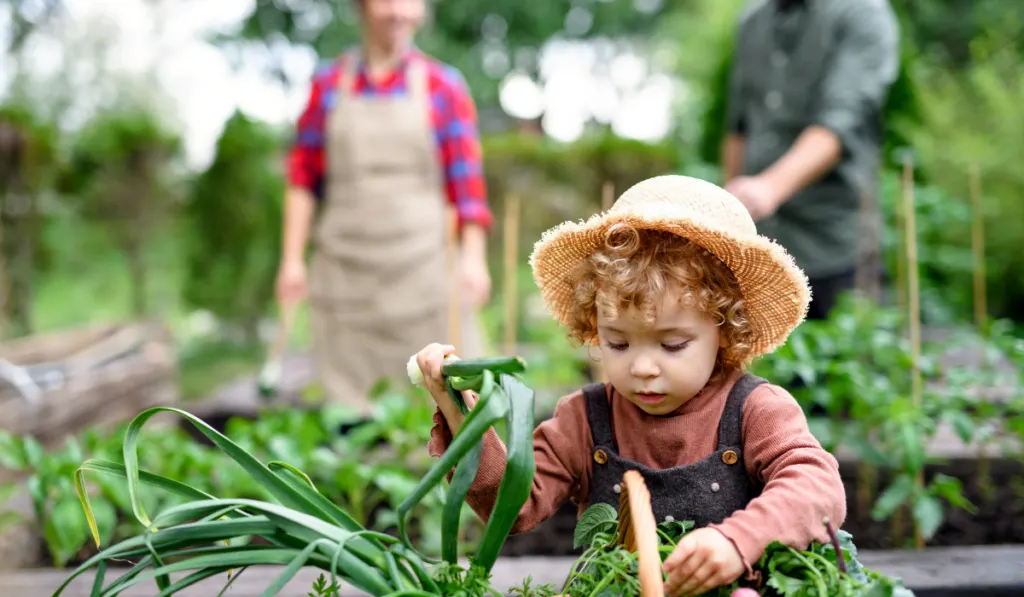
Plants need sunlight for their growth but every plant has its sunlight requirement. You have to take note of their requirements while planting.
There are two factors you should consider when arranging your garden: the height of the mature plant and the light requirements. These 2 factors are usually specified on the pack of the seeds for the plant.
Height of the Mature Plant
The height of the mature plant will determine where you sow different plants relative to each other. The taller plants should not be in the way of shorter plants that need direct sunlight.
Conversely, if a shorter plant does not need too much sunlight, the taller plant should be sowed in a position that allows it to provide shade to the shorter plant.
Light
Light requirements for plants is usually described in 3 ways:
- Full Sun
- Partial Shade
- Full Shade
Plants that require full sun should be exposed to direct sunlight for at least 6 hours per day.
The hours between 10 a.m. and 6 p.m. are usually the best for sunlight exposure. In colder regions, the minimum duration of exposure should be 8 hours because the sun is less intense.
For plants that require full sun, you should arrange the garden in a way that puts the taller plants out of the way of direct sunlight.
If your plant requires partial shade, this means you should expose it to direct sunlight for less than 6 hours daily. The exposure time should fall between 3 and 6 hours. To do this, you may sow the plant in a moderately shaded area.
Alternatively, you can adapt dappled sunlight exposure. A good way to do this is to place taller plants in positions where they can shade shorter plants that need partial shade.
For plants that require full shade, they should be exposed to very little or no sunlight. Most plants (especially vegetables) need light to grow. So, you may not need to bother about providing full shade for your plant except when specified.
Raised-Bed Planting Guides for Your Favorite Meals
Now, we have garden layout ideas for your favorite meals from some regions of the world. For this layout, each row consists of four 1-square-foot sections.
Mediterranean
- 2 rows of 240 carrot seeds (thin to 128 plants)
- 1 row of 4 cabbages
- 1 row of 8 celeries
- 1 row of 64 lettuces
- 1 row of 4 bush cucumbers
- 1 row of 72 beet seeds (thin to 36 plants)
- 1 row of 36 onions
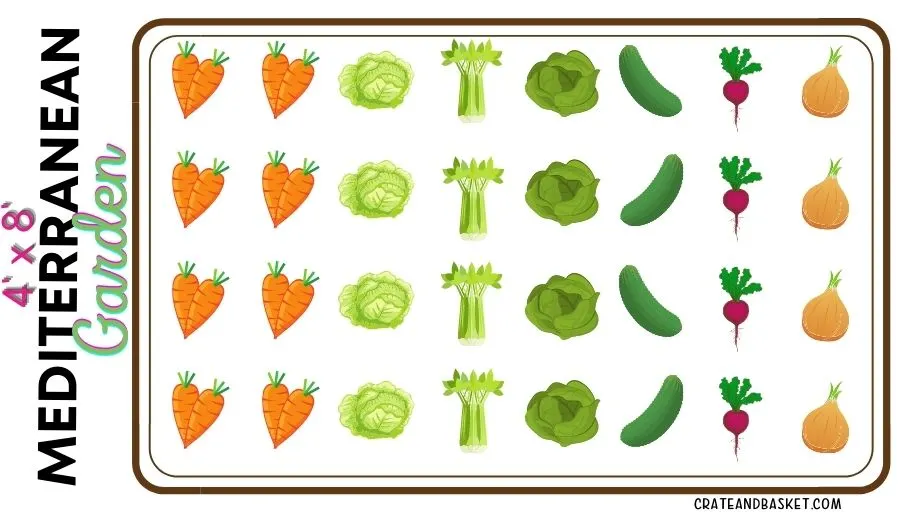
Italian
- 1 row of 4 broccolis
- 1 row of 4 radicchios
- 1 row of 72 parsnip seeds (thin to 36 plants)
- 1 row of 4 cauliflowers
- 1 row of 4 eggplants
- 2 rows of 16 green beans
- 1 row 4 tomato plants
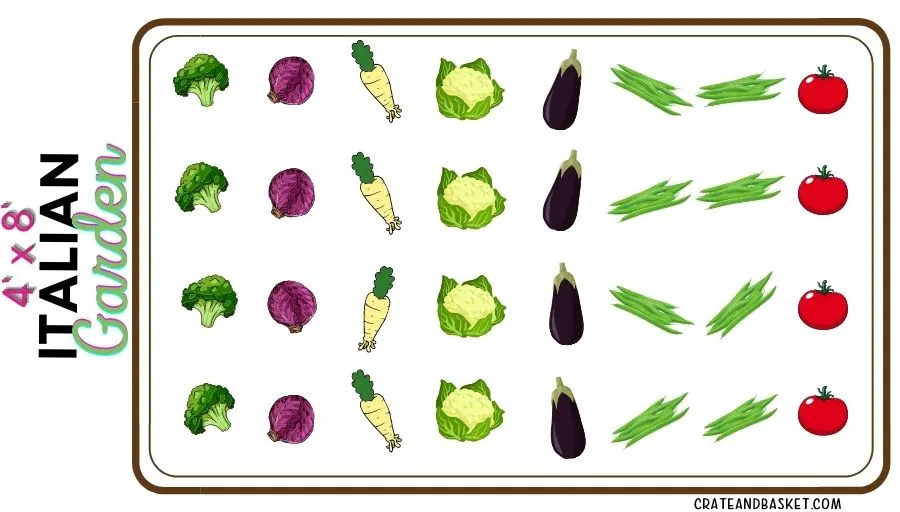
Indian
- 1 row of 16 kohlrabi
- 2 rows of 8 turmeric plants
- 1 row of 72 spinach seeds (thin to 36 plants)
- 1 row of 36 curry leaf plants
- 1 row of 4 tomato plants
- 2 rows of 72 onions
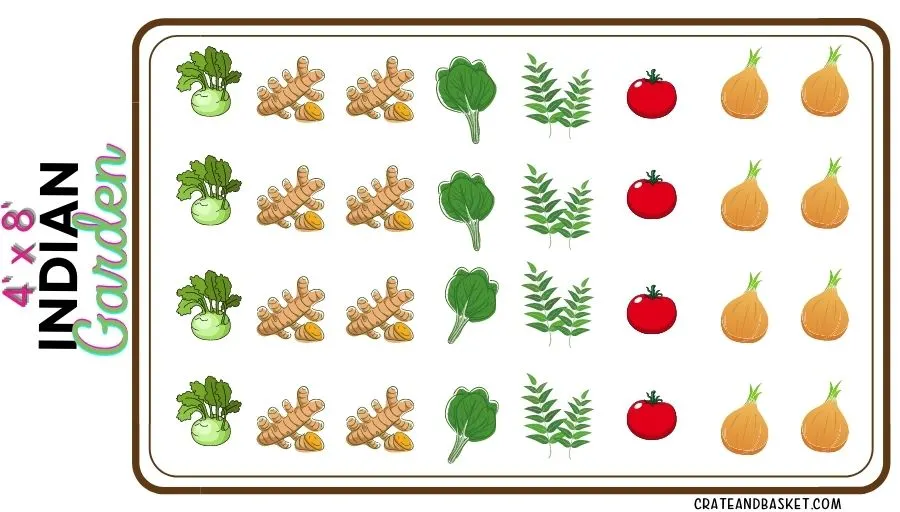
Chinese
- 2 rows of 32 Bok Choy plants
- 1 row of 36 Chinese Cabbage seedlings (thin to 4 plants)
- 1 row of 64 Chinese Eggplants
- 1 row of 64 white radishes
- 1 row of 64 peas
- 1 row of 16 water spinaches
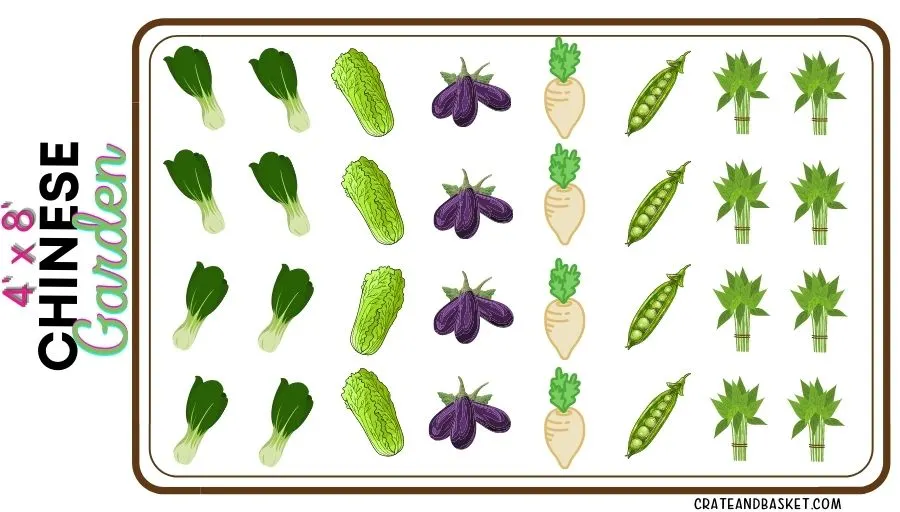
French
- 2 rows of 8 tomatoes
- 1 row of 120 carrot seeds (thin to 64 plants)
- 1 row of 4 cauliflowers
- 1 row of 4 basil plants and 2 cherry tomato
- 1 row of 4 cherry tomato plants
- 1 row of 24 leeks
- 1 row of 16 chicories
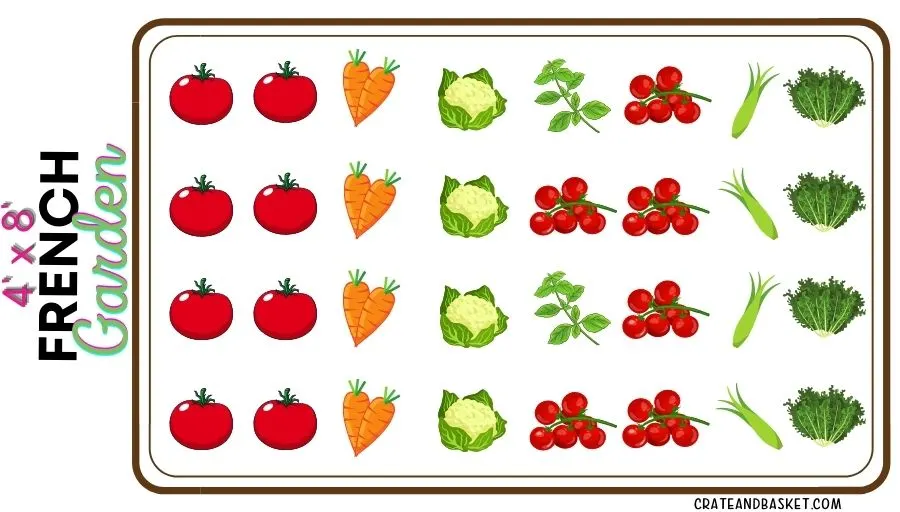
Mexican
- 1 row of 144 Jicama seeds (thin to 16 plants)
- 1 row of 4 tomato plants
- 1 row of 4 tomatillos
- 1 row of 16 corn seeds (thin to 8 plants)
- 1 row of 2 tomatillos and 8 corn seeds (thin to 4 plants)
- 1 row of 36 onions
- 1 row of 8 basils
- 1 row of 2 chilies and 2 summer squashes

American
- 1 row of 1 bell pepper and 2 chili
- 1 row of 4 tomato plants
- 2 rows of 72 onions
- 1 row of 4 broccolis
- 1 row of 3 bush cucumbers
- 1 row of 16 arugulas, 4 basils, and 1 eggplant
- 1 row of 16 garlic plants
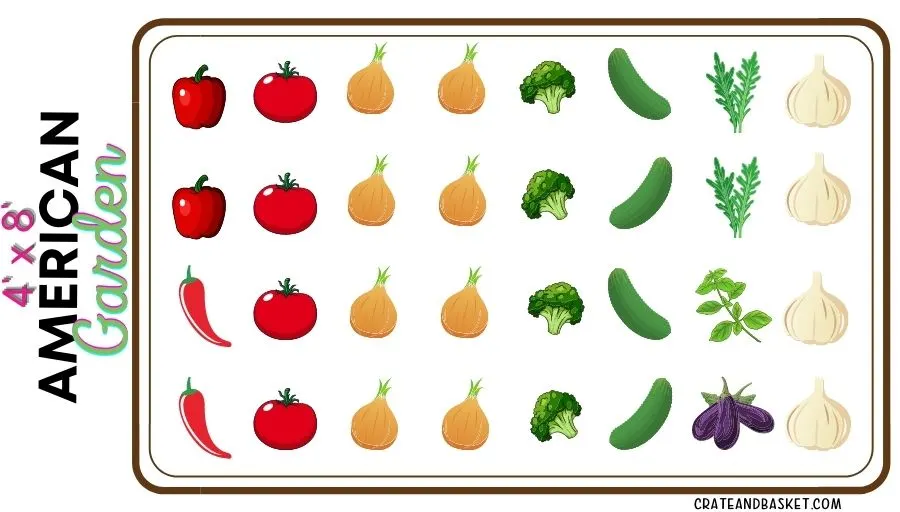
Cajun
- 1 row of 36 onions
- 1 row of 16 garlic plants
- 1 row of 4 summer squashes
- 1 row of 4 tomato plants
- 1 row of 4 paprika plants
- 1 row of 16 cayenne
- 1 row of 2 bell peppers
- 1 row of 8 basils
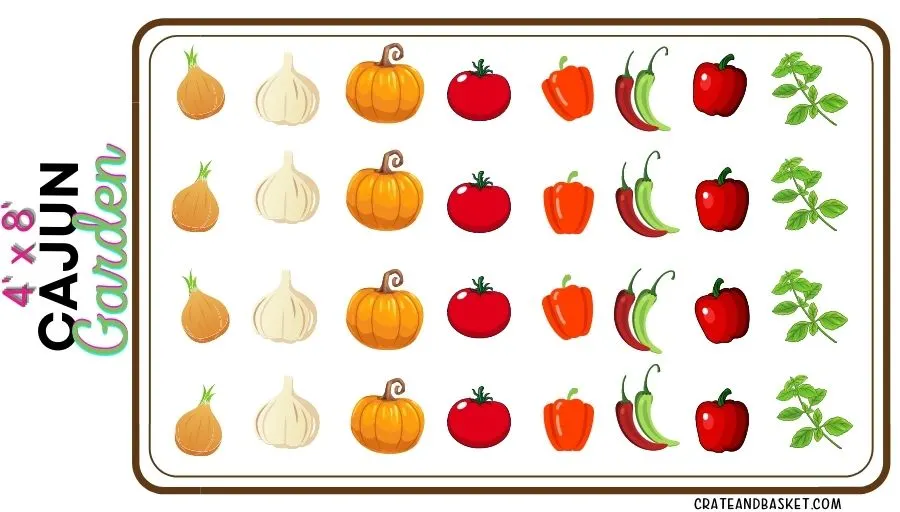
Resources
- https://homeguides.sfgate.com/what-is-row-planting-13428343.html
- https://growagoodlife.com/vegetables-that-grow-in-shade/
- https://www.nourishingpursuits.com/garden/read-seed-packets/
- https://www.gardeners.com/on/demandware.store/Sites-Gardeners-Site/default/KGP-Design
- https://gardeninminutes.com/plant-spacing-chart-raised-bed-gardening/
- https://savvygardening.com/4×8-raised-bed-vegetable-garden-layout/
- https://thedemogarden.org/garden-templates/
